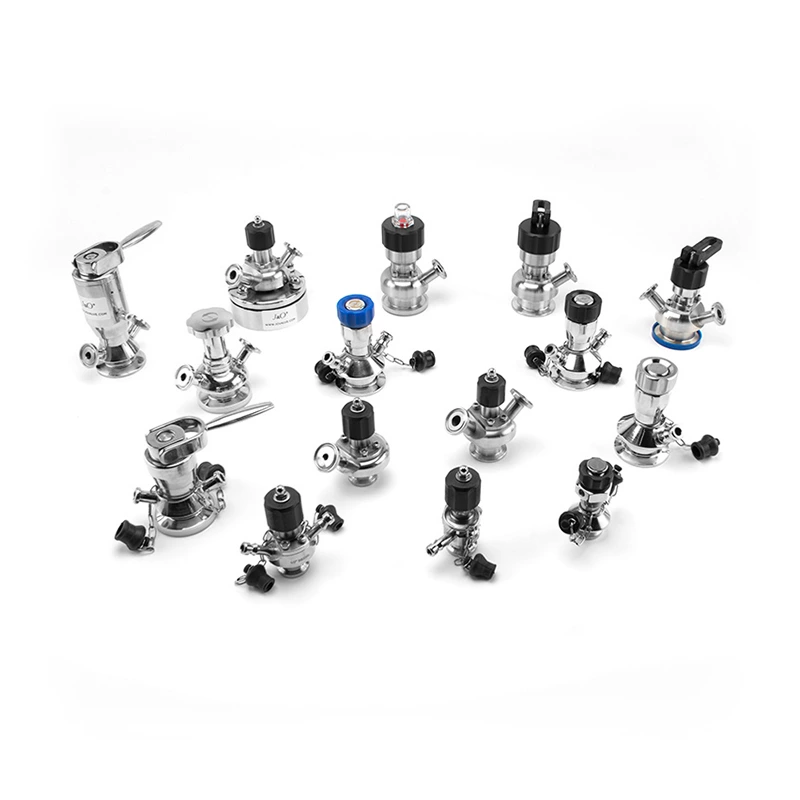Introduction To The Structural Characteristics Of Sterile Sampling Valve
The structure of Sanitary Aspetic Sampling Valve mainly includes sealing rubber sleeve, sample chamber, sampling port, stainless steel ejector, spring, ejector sleeve, manual rotary handle (the difference between automatic aseptic sampling valve and manual one is whether pneumatic device is used. The basic principle is the same. Normally, aseptic sampling valves are equipped with sampling port seals of suitable size). Its basic working principle is that when it is in the closed state, the ejector is pushed by spring tension or other pressure, and the sealing rubber head is pressed against the opening of the tank wall by the ejector to achieve the sealing effect. If sampling is required, steam or other sterilization medium is introduced from one of the sampling ports to fill the entire sample chamber and lead it out from the other sampling port. After a certain period of time, the sample chamber and the sampling port are in a sterile state. Then, by twisting the rotary handle, contracting the spring, and relaxing the ejector, the sealing rubber head is separated from the opening on the tank wall, so that the sample flows out of the tank through the sample chamber and is collected from the sampling port. After sampling is completed, twist the rotary handle, relax the spring, and press the sealing rubber head against the opening of the tank wall again through the ejector.
Clean water is introduced to discharge the residual liquid in the sample chamber, and then the sterilization medium is injected to seal and retain it for the next sampling. The application points of the aseptic sampling valve include cold wort, fermentation liquid, yeast mud, deoxygenated water, sake, sterile water, etc. From the above-mentioned usage principle, it should be said that under normal use and maintenance, the large-scale use of special aseptic sampling valves at the production site is undoubtedly one of the effective means to improve the level of microbial management and control. However, in terms of being able to clearly understand the role and influence of aseptic sampling valves and the use and maintenance of them, it should be said that there are still certain deficiencies - it can improve the accuracy of sample sampling and provide a comprehensive understanding of the sample properties, but it will also cause sample contamination due to negligence in operation and affect the judgment of the results, and even cause overall contamination of the sampled medium due to deficiencies in maintenance and management. Here are some examples and analysis of the situations that have been encountered. *, application on the pipeline. Take the aseptic sampling valve installed on the wort pipeline as an example. In the early days, the first batch of wort after CIP was found to be contaminated during microbial testing, but the second and third batches were not. Moreover, the top water temperature was high, reaching above 85°C. All pipeline materials should be made of stainless steel, which is present throughout the process. The compressed air used for oxygenation is also sterile after being filtered through a sterile membrane. This raises the question of where the contaminated microorganisms come from? After analysis, the suspect is the aseptic sampling valve. Wort, as a nutrient-rich matrix required for yeast growth, has a relatively high sugar content. When sampling, the wort flows through the openings, sample chambers and sampling ports on the pipe wall. When cleaning after sampling, the residues in the sample chamber and sampling port can be easily removed, but the contact part between the sealing rubber head and the pipe wall is not easy to be removed. It is even more difficult to remove when it becomes sticky due to heat during the next sampling and sterilization. After a long time, a sanitary dead corner will be formed. The discovery when the aseptic sampling valve was disassembled and inspected confirmed the above suspicion.
